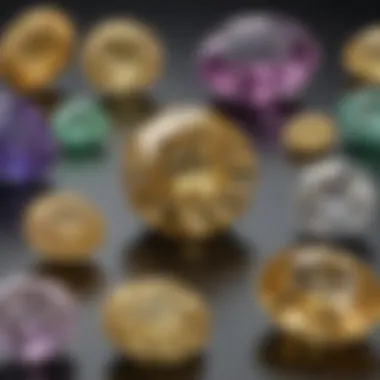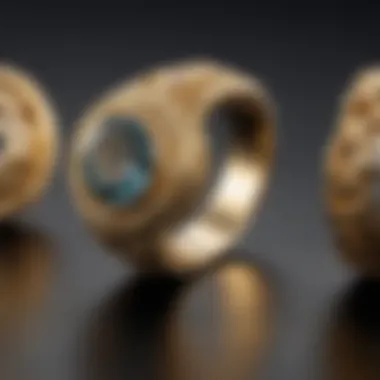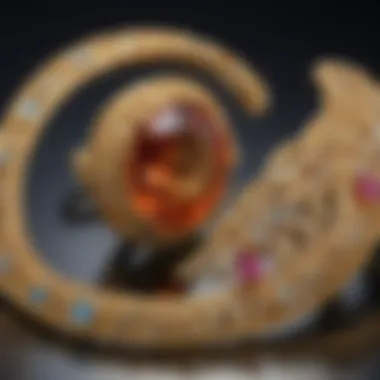Understanding 10 Karat vs 14 Karat Gold Differences


Intro
When it comes to gold jewelry, many buyers face a choice between different karats, notably 10 karat and 14 karat gold. Understanding the distinctions between these two options is essential, as it affects both the aesthetic appeal and the practical applications of the jewelry. This article delves into the unique characteristics of each type, examining their composition, purity, cost, and overall suitability for various jewelry forms.
Gemstone Overview
Definition and Characteristics
Gold itself is a precious metal often used in jewelry due to its luster and resistance to tarnish. However, gold in its pure form, known as 24 karat gold, is too soft for everyday wear. Therefore, it is alloyed with other metals, creating different karat levels. Both 10 karat and 14 karat gold are popular choices among consumers looking for durability and beauty.
The primary difference lies in the metal content: 10 karat gold contains 41.7% pure gold, while 14 karat gold has a higher purity level at 58.3%.
Classification of Gold Alloys
Gold alloys are classified based on their karat percentage. Here are some common classifications:
- 24 Karat Gold: 99.9% pure gold, very soft and malleable.
- 22 Karat Gold: 91.6% pure gold, relatively soft but commonly used in certain regions.
- 18 Karat Gold: 75% pure gold, known for durability and beauty.
- 14 Karat Gold: 58.3% pure gold, popular for jewelry, provides balance between cost and quality.
- 10 Karat Gold: 41.7% pure gold, often more affordable and sturdy for everyday wear.
Properties of Gold Alloys
Physical Properties
- Color: The color of gold can vary depending on the alloys used. 10 karat gold is usually a paler yellow compared to the richer hue of 14 karat gold. Other alloys like copper and silver can influence this color.
- Durability: Generally, 10 karat gold is more durable than 14 karat gold due to the higher percentage of alloy metals. This makes it more suitable for everyday pieces.
- Weight: Higher karat gold will weigh more than lower karat gold. This aspect is often overlooked but can be a consideration for specific jewelry designs.
Chemical Properties
When considering the chemical makeup of gold alloys, understanding the components is crucial.
- Corrosion Resistance: Gold, being a noble metal, resists corrosion well. This applies to both 10 karat and 14 karat gold, although higher purity gold may have better resistance compared to lower purity.
- Allergic Reactions: Some individuals may experience skin reactions to the alloys in gold jewelry. Nickel is a common allergen, so it is important to check for hypoallergenic options if allergic reactions are a concern.
"The choice between 10 karat and 14 karat gold impacts more than just aesthetic appeal; it influences durability, cost and personal comfort as well."
End
Prologue to Gold Karats
Gold karats are a crucial aspect of understanding the quality and value of gold jewelry. The term "karat" refers to the measure of the purity of gold, with higher karat numbers indicating a higher percentage of gold content. This measurement influences various factors, including durability, appearance, and market value, making it vital for consumers and jewelers alike to comprehend its significance. The ability to differentiate between karat levels can guide prospective buyers in making informed decisions about their jewelry investments.
In this article, we will explore the differences between 10 karat and 14 karat gold. Each karat level has its unique attributes, affecting everything from cost to suitability for specific uses. With a deeper understanding of these distinctions, readers will appreciate the nuances of their choices and understand the broader implications in the realm of gems and fine jewelry.
Definition of Gold Karats
Gold karats are a standard measurement used to express the purity of gold in an alloy. Pure gold is often considered 24 karats, indicating that the gold is 100% pure. However, in practical applications, pure gold is often alloyed with other metals to enhance its durability and alter its color. Thus, a lower karat number means less gold content. For example, 10 karat gold is made up of 10 parts gold and 14 parts other metals, resulting in approximately 41.7% gold content. Meanwhile, 14 karat gold consists of 14 parts gold and 10 parts additional metals, translating to around 58.3% gold.
This distinction not only defines the intrinsic value of the jewelry piece but also impacts its durability and appearance. Understanding the definition of gold karats is fundamental for anyone looking to invest in or create jewelry.
Historical Context of Gold Purity Measurement


The measurement of gold purity has a rich and storied history that dates back thousands of years. Various civilizations developed their methods for assessing gold purity, reflecting their technologies, economies, and cultures. In ancient Egypt, for instance, jewelers utilized specific weights of gold to determine its value. Later, during the Middle Ages, the concept of using karats emerged as trade flourished in Europe. This standardized system helped streamline commerce and ensure transparency in gold transactions.
Today, the karat system is widely accepted across the globe. It serves not only as a guide for consumers but also as a regulatory measure for jewelers. Understanding this historical context enhances the appreciation of gold's enduring value and the measures that have arisen to ensure its integrity.
What is Karat Gold?
Understanding 10 karat gold is essential in distinguishing its properties from other forms of gold. This subsection examines what makes 10 karat gold unique, its composition, purity, and the value considerations associated with it. Given its prevalence in the jewelry market, knowledge about 10 karat gold aids consumers in making educated decisions. Its mixture of gold and alloy metals impacts durability, appearance, and price.
Composition of Karat Gold
10 karat gold consists of 41.7% pure gold and 58.3% other metals. The primary alloys used include copper, silver, and zinc. The proportion of gold in 10 karat gold is lower compared to higher karat options like 14 karat gold, which has 58.3% pure gold. This composition affects both the color and strength of the gold, creating a sturdy yet affordable option for jewelry. The use of different alloys can also change the hue of 10 karat gold, with variations ranging from yellow to white gold, depending on the specific metals blended.
Purity and Value Considerations
The lower gold content in 10 karat gold results in a different value proposition. Its 41.7% purity means it is less expensive than higher karat options. This can be appealing for budget-conscious consumers. However, it is essential to consider the trade-offs in terms of jewelry longevity and appearance. 10 karat gold can tarnish over time, primarily due to the alloy metals used. Regular maintenance, including cleaning and proper storage, can enhance its appearance and lifespan. For potential buyers, understanding these nuances aids in assessing whether the cost savings align with their expectations of durability and aesthetic quality.
Applications of Karat Gold in Jewelry
10 karat gold is widely used in various types of jewelry, reflecting its durability and affordability. Common applications include:
- Rings: Engagement and wedding bands often utilize 10 karat gold due to its strength.
- Earrings: Studs and hoops can be made from this gold, catering to everyday wear.
- Necklaces and Bracelets: The combination of style and sturdiness makes 10 karat gold ing or chains a popular choice.
"The allure of 10 karat gold lies in its balance of affordability and durability, making it a leading choice for everyday jewelry."
Understanding these aspects enriches the buyer's knowledge and helps in selecting the right piece.
What is Karat Gold?
The term 14 karat gold denotes a specific type of gold alloy that is composed of 58.3% pure gold, with the remaining 41.7% comprising other metals. This ratio strikes a balance between the luxurious qualities of gold and the strength provided by its alloying elements. Understanding 14 karat gold is essential for consumers who seek both beauty and durability in their jewelry choices.
Composition of Karat Gold
The composition of 14 karat gold is crucial for several reasons. The alloy typically includes metals like copper, silver, or zinc. These metals enhance the overall durability, making 14 karat gold more resistant to scratches and bending compared to higher karat gold options. The specific blend of additional metals can also influence the color of the final product. For instance, if copper is more prevalent, the tone may exhibit a warm reddish hue, while mixing with silver can result in a whiter appearance. The precise formula and proportions can vary by manufacturer, allowing for customization that caters to specific consumer preferences.
Purity and Market Value Analysis
In terms of purity, 14 karat gold stands out because of its balanced composition. While 10 karat gold contains only 41.7% gold, 14 karat gold contains a significant amount more. This higher gold content contributes to its value, making it more sought after in the market. The market value of 14 karat gold is reflective not only of its gold content but also of market demand and associated trends.
"Gold karats serve as a hallmark of quality and craftsmanship in jewelry making. 14 karat gold is often perceived as a mid-range option offering both value and luxury."
Consumers often prioritize 14 karat gold in wedding bands and fine jewelry due to its durability and aesthetic appeal. When considering resale value, 14 karat gold generally retains a better price percentage than lower karat options.
Jewelry Styles Featuring Karat Gold
The versatility of 14 karat gold is evident in the variety of jewelry styles available in this alloy. It is commonly found in:
- Engagement and wedding rings: Many couples prefer 14 karat gold for its ability to withstand daily wear while still possessing an elegant appearance.
- Necklaces and pendants: The richness of 14 karat gold enhances the visual appeal of any neckpiece.
- Bracelets and earrings: The durability allows for intricate designs without compromising strength.


Designers often choose 14 karat gold to create unique pieces that can be enjoyed for years. As it is less soft than 18 karat gold, it allows for more complex craftsmanship while maintaining its luster and strength. Consumers appreciate its rich history, accessible pricing, and enduring qualities.
In summary, 14 karat gold proves to be a compelling choice for both jewelers and buyers. Its blend of purity, valuable market positioning, and stylish adaptability makes it an appealing option for all kinds of jewelry.
Comparative Analysis of Karat and Karat Gold
The comparative analysis of 10 karat and 14 karat gold presents an essential insight for those interested in jewelry. Understanding how each karat affects various aspects of gold can greatly influence purchase decisions for consumers, collectors, and designers alike. This section examines fundamental factors such as metal durability, color differences, and resale values that can affect long-term investment strategies in gold jewelry.
Metal Durability and Hardness
When it comes to the durability and hardness of gold, the composition plays a crucial role. 10 karat gold contains 41.7% pure gold and 58.3% other metals such as copper, silver, or zinc. This higher alloy content results in a sturdier metal that can withstand daily wear better than higher karat options. 14 karat gold, on the other hand, comprises 58.3% pure gold and 41.7% other metals. As a result, it is less durable due to its higher gold content, making it softer and more susceptible to scratches and dents.
Choosing between the two often depends on the intended use. For instance, if the piece is for everyday wear, like a wedding band or a frequently used pendant, 10 karat gold may be preferable. Conversely, for more intricate designs worn occasionally, 14 karat gold may hold a greater aesthetic appeal despite its relative softness.
Color and Appearance Differences
The color variations between 10 karat and 14 karat gold can be subtle yet significant. 10 karat gold usually appears paler than its 14 karat counterpart. The addition of more alloyed metals can dilute the rich yellow hue typical of gold. 14 karat gold exhibits a warmer tone due to its higher gold percentage, making it more appealing for classic designs.
It is also essential to note that alloy compositions can change the hue. For example, pieces made from rose gold often include copper, which alters the color. Therefore, both 10 and 14 karat gold can present a variety of shades based on their specific metal mixtures.
Resale Value Considerations
Resale value is a vital aspect to consider when investing in gold jewelry. Generally, 14 karat gold tends to have a higher resale value compared to 10 karat gold. Since 14 karat gold contains more pure gold, it retains value better over time. In contrast, the increased alloy content in 10 karat gold means it is less valuable in melting terms. Although jewelry can often have personal or design value that outstrips simple material worth, understanding the monetary side is important for future selling or trading.
Cost Implications of Karat vs Karat Gold
The discussion of cost implications between 10 karat and 14 karat gold is essential for consumers and jewelry enthusiasts alike. Understanding these costs helps buyers make informed decisions regarding their purchases. Price does not simply reflect the aesthetic value of the jewelry, but also indicates the metal’s purity and composition, resulting in differing values and long-term advantages. As such, considering these factors can lead to a better financial investment in jewelry.
Pricing Structures and Factors
The pricing of gold jewelry is primarily influenced by several factors, including the karat rating, the gold market price, craftsmanship, and design. Here are some points to consider:
- Karat Rating: The karat of gold directly affects its price. Since 14 karat gold contains more pure gold than 10 karat gold, it generally costs more. In other words, 14 karat gold consists of 58.3% gold, compared to 10 karat gold, which contains 41.7% gold.
- Market Price: The market price of gold fluctuates daily. Higher market prices impact all gold jewelry prices. When gold prices rise, the prices of both 10 and 14 karat gold will increase.
- Craftsmanship and Design: Well-crafted pieces, especially intricate designs, can also add significant cost. Unique designs from reputable jewelry designers may enhance the value irrespective of the karat rating.
- Alloy Composition: The metals used to create the alloy can also play a role in pricing. The choice of metals included in lower karat gold can affect its durability and market value.
Understanding these aspects can help buyers comprehend why specific pieces have their particular price tags.
Budget Considerations for Consumers
When considering whether to buy 10 karat or 14 karat gold, budgeting is an important factor. Here are a few points to keep in mind:
- Initial Cost: 10 karat gold is generally more affordable compared to 14 karat gold. This is an appealing option for consumers seeking stylish jewelry on a budget without compromising too much on quality.
- Longevity and Durability: Investing in 14 karat gold can be wise due to its higher purity, making it less susceptible to scratches and dents. Longer-lasting items might save money over time, despite the higher upfront cost.
- Potential Resale Value: Gold jewelry often holds its value, and while 10 karat gold can be appealing for its price, 14 karat gold might provide better resale options due to its higher precious metal content.
- Personal Budget Planning: It is crucial to analyze one’s own financial situation before making a purchase. Understanding both immediate and long-term costs will help in formulating a realistic budget that aligns with lifestyle and preferences.
Health and Allergic Reactions
Awareness about health and allergic reactions is crucial when choosing gold jewelry. Many people do not consider that the alloys mixed with gold can cause skin irritation or allergic responses. Understanding the implications of these reactions can prevent discomfort and inform better purchasing decisions, especially for those with sensitive skin or allergies.
Common Alloys in Gold Jewelry


Gold in its purest form is not suitable for day-to-day jewelry as it is very soft. Thus, it is often alloyed with other metals to improve its durability. Common alloys include:
- Copper: Frequently used in both 10 karat and 14 karat gold, copper helps harden the metal while lending a reddish tint.
- Silver: Known for its bright and shiny appearance, silver is often mixed with gold to enhance its luster without overpowering its intrinsic qualities.
- Palladium and Nickel: Particularly in white gold, these metals can provide strength and a distinctive color. However, nickel is known for triggering allergic reactions in many individuals.
Each of these metals plays a vital role in the final product, and the specific composition depends on whether the gold is 10 karat or 14 karat.
Skin Sensitivity and Gold Purity
Skin sensitivity can vary widely. While gold itself is hypoallergenic, the presence of alloys can create issues. In the case of 10 karat gold, the lower gold content means that other metals comprise a more significant portion of the alloy. Consequently, the risk of allergic reactions is higher. Symptoms can range from mild irritation to severe redness or rashes.
In contrast, 14 karat gold, containing a higher percentage of gold, usually results in fewer allergic reactions because it has less of these potentially problematic metals. People with metal allergies often find 14 karat gold more suitable for everyday wear.
It's essential for consumers to be aware of their skin's sensitivity to specific metals and opt for higher purity gold to minimize adverse reactions.
When shopping for gold jewelry, especially for those prone to allergies, it is advisable to inquire about the specific alloys used. Being informed empowers buyers to make choices that align with both their style and health needs.
Consumer Preferences and Trends
Understanding consumer preferences and trends regarding gold purchases is crucial for those involved in the jewelry market. The demand for gold jewelry, particularly in the contexts of 10 karat and 14 karat gold, reflects broader social and economic patterns. This section will explore how consumers evaluate the two types of gold and their choices are influenced by various factors.
Market Analysis of Gold Preferences
In the world of gold jewelry, market analyses reveal distinct trends in consumer preferences. Preferences for 10 karat versus 14 karat gold often come down to a combination of factors such as price, durability, and perceived value.
- Price Sensitivity: Many consumers prioritize cost, especially in today's economy. 10 karat gold, being more affordable due to its lower gold content, attracts budget-conscious shoppers. It can be appealing for those purchasing gifts or jewelry for children or teenagers.
- Durability Considerations: Some consumers lean towards 10 karat gold because its robust nature makes it less likely to suffer damage. In contrast, 14 karat gold is softer; thus it may require more care.
- Trends in Precious Metals: This market analysis also reflects current trends in precious metals. The rising gold prices may push consumers to consider lower karat options like 10 karat gold for everyday pieces.
"Understanding the nuances in market demand helps jewelers position their products effectively and cater to consumer needs."
Trends in Jewelry Design Choices
Consumer trends also manifest in the types of designs favored by buyers of 10 karat and 14 karat gold jewelry. For instance, the rise of minimalist design has influenced preferences in gold jewelry.
- Simplicity and Elegance: Many consumers currently favor simple, elegant pieces. This affinity for minimalism often leads them to choose 14 karat gold, perceived as higher quality for elegant everyday wear.
- Personalization and Customization: Custom pieces are gaining traction. Consumers are now more inclined to engage with jewelers who offer personalized designs, regardless of the karat. They appreciate unique items that tell a story or reflect their personal style.
- Sustainable Choices: As awareness around ethical sourcing and sustainability increases, many consumers are becoming more thoughtful about their gold purchases. Some prefer recycled gold, be it 10 karat or 14 karat, to lower the environmental impact of their jewelry choices.
Understanding these trends helps jewelers adapt their offerings to meet changing consumer preferences. By keeping an eye on market dynamics and design choices, they can align their strategies with customer expectations.
The End and Recommendations
The conclusion of this article serves to encapsulate the vast array of information discussed regarding 10 karat and 14 karat gold. Understanding the differences between these two gold purity levels is crucial for consumers, jewelry designers, and collectors alike.
Given their distinct compositions, market values, and applications in jewelry design, buyers need to be informed. The conclusion reiterates that each variant has its unique benefits and potential drawbacks. For instance, while 10 karat gold is more affordable and durable, 14 karat gold often presents a higher purity, translating into a more premium product.
Furthermore, this section emphasizes considerations such as personal preferences, budget limitations, and skin sensitivities. Buyers should think deeply about their intended use, as these factors will influence their choice significantly.
Summarizing Key Points
To summarize, here are the key points readers should take away from this comparison:
- Composition: 10 karat gold contains only 41.7% gold, whereas 14 karat gold consists of 58.3% gold.
- Durability: 10 karat gold is harder and more resistant to scratches due to its higher alloy content. 14 karat gold, while softer, offers a more luxurious feel due to its higher gold content.
- Cost: Generally, 10 karat gold is less expensive than 14 karat, making it a practical option for budget-conscious buyers.
- Allergic Reactions: Individuals with skin sensitivities may react differently to the alloys found in each purity level, making personal experiences vital in the decision-making process.
- Market Preferences: Demand for 14 karat gold often comes from its perceived value and rich color, while 10 karat gold appeals to those valuing durability and affordability.
Making Informed Choices
In the end, making an informed choice between 10 karat and 14 karat gold involves several steps:
- Assessing Purpose: Determine what use the gold will have. Is it for everyday wear or a special occasion?
- Understanding Skin Sensitivities: If allergic reactions are a concern, consult with a jeweler about the alloys in the gold.
- Considering Budget: Compare the long-term investment against immediate costs. Will the jewelry be a statement piece or an everyday accessory?
- Researching Options: Take time to research the available styles and designs in both 10 karat and 14 karat gold.
- Consulting Experts: Speaking with jewelry professionals can provide valuable insights about the best choices tailored to individual preferences.



